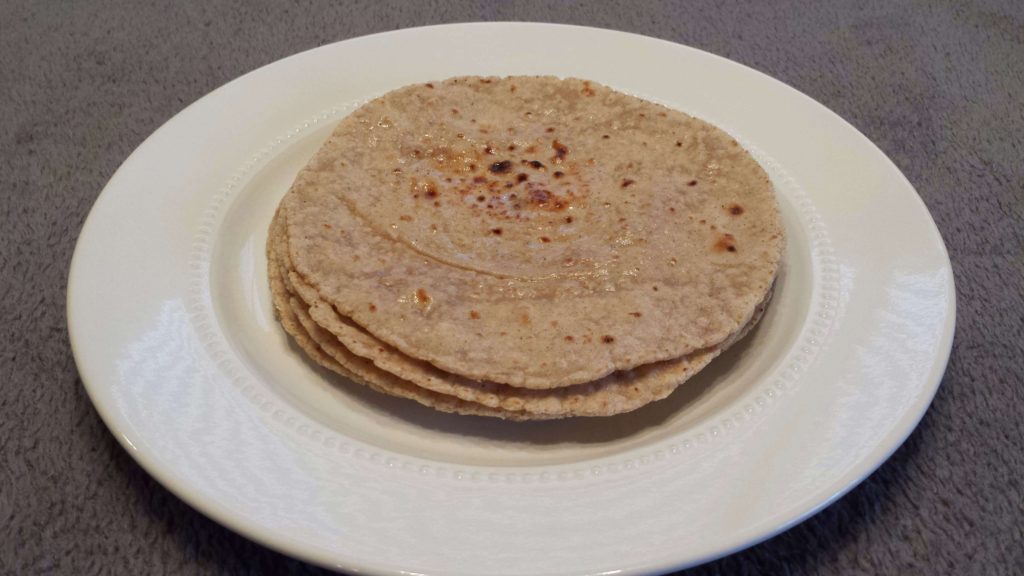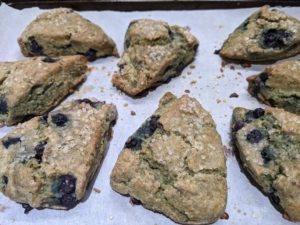Yield: 6 flatbreads of about 5-6 inches in diameter
Prep time: 5 minutes
Resting time: 15-20 minutes
Cook time: 15 minutes
Total time: 20 minutes
Ingredients
- 1 cup of Metta flour
- ½ cup water at room temperature
- ¼ teaspoon of salt
- ¼ cup of dry Metta flour (for dusting and sprinkling)
- (optional) ⅛ tsp baking soda*
- (optional) ¼ tsp lemon or lime juice*
- (optional) 1 -2 tablespoon of plain yogurt (dairy or non-dairy)**
- (optional, but recommended) 1-2 tablespoon of oil or ghee to spread on the flatbread once cooked*
Note: *The lemon or lime juice activates the baking soda to make the chapatis softer and fluffier. Even without these two optional ingredients, the chapatis still come out soft and puff up nicely. I just like to add them especially if I’m planning to freeze them for later use.
**I sometimes like to add a tablespoon or two of yogurt to make the chapatis and tortillas extra soft. If you do, remember to use slightly less water. I prefer to put a little oil, about 1 teaspoon, on the cooked chapati to keep the top moist, especially if saving it for later. Of course, you can choose one or the other options, baking soda with lemon juice or the yogurt to make the chapatis softer or you can use neither. The chapatis will still come out tasty and pliable. However, I recommend that you DON’T USE OIL in the dough because I find that it weighs the dough down preventing the chapatis from fluffing up well.
Tools Needed
- Rolling pin
- Skillet (preferably hard anodized pan)
- Rolled up clean paper towel or muslin cloth
Tools needed if using a Tortilla Press
- Quart size zip lock bag
- Scissors
Instructions
- In an open wide bowl, stir together the flour, salt, and water (and yogurt if preferred or the soda and lemon/lime juice). Mix and knead until the dough starts to pull away from the sides. (I knead the dough in an electric mixer for about 5 minutes using the dough hook so it is kneaded to perfection without tiring the arms.)
- If the dough seems too dry, add a little water and if it is too sticky, add a little flour. It should not stick to your hands nor should it be wet. Knead the dough until a soft pliable dough is formed. One of the secrets for soft flatbread is dough that is well kneaded.
- Once a soft yet firm dough is achieved, put it in a container with a cover to avoid developing dry skin on it. For best results, leave it in the fridge for at least 15-20 minutes. For best results, use dough within 48 hours of initial kneading.
- Preheat lightly oiled skillet, or tawa, to medium-high heat. Smear a little dry flour on your hands before making the dough balls to prevent the dough from sticking to your hands. Divide the dough into small balls (about 2-inches in diameter and 1-inch think). Make the dough balls a size you can easily manage. You can either make all the dough balls at once or one-at-a-time as you cook each chapati on the skillet.
- When ready to roll, dip each dough ball in its entirety into dry flour to avoid sticking to the rolling pin. Place it on a clean counter top, or chokki, to roll using a rolling pin.
- Start rolling it evenly applying gentle pressure (if it starts breaking or sticking to the counter or rolling pin, you may be pressing too hard). Turn it over if needed forming a nice round circle. Don’t worry if you are not able to make it a nice round shape. In order for the chapati to rise and puff up on the skillet, it is important for it to be evenly flattened all around. You will likely need to use more dry flour while rolling it to prevent it from sticking to the counter. Brush off the access dry flour it doesn’t start of settle on the chapati dough as you’re rolling it. Thin it out to your preference. If thinner than 1 mm, it may not puff up.
- You can also start out using a tortillas press, which can help create a nice round shape with even pressure:
- Cut both side seams of a quart size zip lock bag, but not the bottom.
- Put this ziploc bag, like a pocket with the open side of the bag near the handle, in the tortilla press.
- Dip the dough ball in its entirety in the dry flour and place it in between the bag in the tortilla press.
- Close and press the tortilla press without applying too much pressure.
- Once you open it, you will have a nice round chapati, which might still be a bit thick in which case…
- Peel it off carefully from in between the ziploc bag and dip both sides in the dry flour and roll the chapati a little bit more using a rolling pin, applying gentle pressure and evenly all around to thin it out.
- Once rolled, carefully place it on a hot skillet. Ideal skillet temperature for the chapati is 500 to 550 F. Let the side cook for about 15-20 seconds.
- When you start seeing small specks of bubbles on the chapati, turn it over.
- Cook the other side for about 40-45 seconds, then turn it again. Leave it cooking for about 3-5 seconds, then using a clean paper towel or muslin cloth, push down the sides very gently. Move to pressing gently particularly on the section that is already puffing up. Keep pressing down on the puffed areas of the chapati causing it to rise and puff up completely. This whole process of helping the chapati to rise should take approximately 10-15 seconds. After it has puffed up all the way or most of the way, remove it from the skillet onto a tortilla warmer dish or in a container in a clean kitchen towel and smear a little oil or butter or ghee on it to lock in some moisture. Don’t worry if it doesn’t puff up all the way, it will still taste good. Be careful not to overcook and get it too crispy because then it may not be as soft.
- Best served warm, with a little oil or butter or ghee on it.
- Repeat steps 5 – 11.
- If making a bunch all at once, it is best to stack them in a paper towel within a container like a tortilla warmer. This will keep them warm and soft for a few hours.
- If any left over, save them in a foil or zip lock bag over night on the counter and eat them the next day after warming in a zip lock bag or a tortilla warmer for 10-15 seconds in the microwave. You can also store them in the refrigerator in a tightly sealed bag and consume within 2-3 days. They may harden slightly as they don’t contain any preservatives, but warming them in the microwave or on a hot (at least 500 F) skillet will make them soft and pliable again. For longer storage, freeze them in a freezer safe ziploc bags. For the freezer, I recommend putting 2 chapatis in a sandwich bag and putting several of those 2-pack bags in a freezer safe ziploc bag, which you can pull out as needed, reheat and enjoy!
Note: If you are new to making chapatis/tortillas, please be patient with yourself, it takes time and some practice to get the hang of it!
Have you used Metta gluten-free flour for this recipe or any other recipe?
Kindly take a moment to leave a review here to help our community!
Any questions or concerns or ideas on how to improve our recipe and/or process, please feel free to contact us at mettagfatta@gmail.com
Check out these videos on how to knead the dough and make the tortillas on Metta Flour YouTube Channel.
Note: There are many other videos on youtube you can watch on how to make the rotis, parathas, puris, and samosas.











